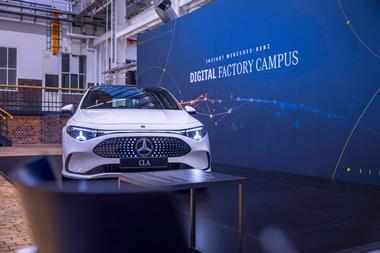AMS speaks to producers and end users of Sperian Welding to find out which features and innovations have made these some of the most popular helmets available on the market. Advances in plant safety are often most apparent in automation control, robot, conveyor and transport systems. Yet one of the most dangerous processes in automotive production is still welding. Where manual welding is carried out on the heavier structural joints in body-in-white, MIG, TIG and arc welding all produce potentially blinding light radiation and sparks from which a welder must be protected. Sperian Welding Protection has made great advances in not only the speed-to-darkness of its welding helmets and masks but also in the extendeduse comfort of its protection systems.
We spoke to Dr. Michael Krueger, R&D Manager at Sperian Welding Protection.
AMS: Tell us about the latest developments in personal protection at Sperian?
 Michael Krueger: The Sperian range for welders consists of different kind of welding helmets, respiratory products and other personal protective equipment. Latest developments include our Expert welding range, including the recently-launched e600 helmets, which have a ‘true colour’ filter, reduced weight and a larger viewing area. In the Professional range, we have the new p500 helmet, which can be customised for welders and companies using exchangeable side parts. For the automotive industry, starting at quite low volumes, customers can have a company logo on the mask or different graphics. These distinguish different groups of welders without having to buy large quantities of masks.
Michael Krueger: The Sperian range for welders consists of different kind of welding helmets, respiratory products and other personal protective equipment. Latest developments include our Expert welding range, including the recently-launched e600 helmets, which have a ‘true colour’ filter, reduced weight and a larger viewing area. In the Professional range, we have the new p500 helmet, which can be customised for welders and companies using exchangeable side parts. For the automotive industry, starting at quite low volumes, customers can have a company logo on the mask or different graphics. These distinguish different groups of welders without having to buy large quantities of masks.
AMS: Do Sperian helmets have a battery back-up, or are they powered only by light source?
MK: We have batteries to support the photovoltaic cells in order to have power in every situation. Usually the welding arc gives enough light to supply the necessary power - except for the first switching; if you start to weld in an absolutely dark area then the cell would be too slow to react if the welding arc had to provide all the power. The additional battery is specifically for these situations. The helmets use dry cell batteries. They are not rechargeable, but have a warning system to indicate when power is getting low. For all new product series we switched to exchangeable batteries to ensure that even in the case of adverse welding conditions, the lifetime of the helmet can be assured.
AMS: What are the major challenges in supplying equipment to the auto industry?
MK: Our automotive customers are not very particular in terms of how they use our equipment, but we do find that because there is so much automation in modern plants, they have quite clean environments compared to other industries.
We are finding that we now sell higher grades of welding masks to the auto industry than in the past. The use of manual welding in automotive has contracted due to the rise in automation, so the welder has won a higher status and demands higher quality equipment.
AMS: In an automotive environment, the welder is working close to a spot weld station and getting a lot of ‘flash’. Is there an issue with light interference triggering the darkening of the helmet?
MK: There are certain things the welder can do with his welding mask; it may darken, even though he may not be welding.  What he can do is adjust the general overall sensitivity. With our masks, he also can also adjust the sensor angle. This just allows light that comes from his workplace to trigger the sensors. AMS: And can the construction of the welding hood incorporate other protection?
What he can do is adjust the general overall sensitivity. With our masks, he also can also adjust the sensor angle. This just allows light that comes from his workplace to trigger the sensors. AMS: And can the construction of the welding hood incorporate other protection?
MK: What we have seen in auto industry is that there is a greater demand for leather ‘hood’ protection. This prevents sparks coming in from behind. These sparks can produce reflections on the welding glass/filters. AMS: Do you have a lot of competition from Far East markets?
MK: We have competitors from the Far East who are able to produce very cost-effective welding masks. However, in the automotive industry, we don’t see a lot of them as for these customers, reliability, comfort and customer service comes first.
AMS: Regarding safety standards, are these comparable between your products and the Chinesemade welding accessories?
AMS spoke to Marian Karkus, Deputy Chief of SUV bodyshop welding at Volkswagen Slovakia about welding, welding helmets and other plant safety challenges.
AMS: Which areas of safety have changed most over the last few years, with the increase in automation, etc?
Marian Karkus: Over the last few years, the concept of safety in the workplace has changed, with a higher emphasis on safety of the workforce. In the past, workers were secured by just one safety measure. Currently, there are double safety measures in place.
AMS: What are the safety challenges in BIW?
MK: Concerning safety, there is the trend towards complete automation. Even though the development is going this way, it is always necessary to analyse in detail all the factors – such as complexity of the car body and effectiveness of implemented resources.
AMS: Do you have any manual welding in the production process?
MK: We still use manual welding in the production process. But we are heading towards a reduced number of such workplaces. These workplaces are changing step-by-step to automated stations. However, it always depends on how demanding the solution is and the possible return on the investment.
AMS: In robotic and other automated areas, do you use gates/ fences or are you moving to safety light curtains? MK: Close to laser stations, the workplace has to be closed because of safety reasons. Where possible, we are trying to develop workplaces with safety light curtains.
MK: China has started to bring in standards on welding masks, but this is still in its early stages, though most Chinese products we have in the European market adhere to European standards. They have lower labour costs, but the comfort level of the product is not the same. Chinese makers may use materials that just about satisfy the basic safety standards.
AMS: Which advances in optical and other technologies have made the most changes to the way you engineer safety equipment?
MK: There haven’t been any revolutionary advances in technology since the introduction of liquid crystal electro-optic cells. That was a revolution in the industry. This started the move from passive glasses and hand shields to electro-optical equipment. There have been a lot of advances, but none have been as revolutionary as this one.
A significant change has been the move from greentint filters to true colour, brilliant filter technology. A lot of recent advances, such as faster reaction times under differing light conditions, are not something that the welder may notice. Of course, he will notice that his eyes are less tired after extended periods of work, but he may not be able to pinpoint where the improvements have been made.
AMS: Where have advances been made in the materials used in helmet construction?
MK: Advances in this area are not readily apparent. We have used different polymers, but not carbon fibre or other exotic materials. There are a number of purchasers or safety-responsible managers who have the last word on which equipment to buy. They compare data sheets and might be inclined to buy a mask with 5μs faster switching time or 5g less weight. However, such small differences are hardly noticeable. In the case of weight reduction, the important point is balance. If a welding mask is well balanced and its gravity forces are centred along the body axis of the welder, this will reduce the perceived weight and the 'stress and strain' experienced by the welder.
AMS: What is Sperian’s USP when it comes to welding helmets?
MK: We have 30 years of experience developing electro-optic masks and along with one competitor, we were the pioneers of this technology. We have dedicated specialists for every facet of the welding mask, including optical scientists, electronics engineers, mechanical engineers. As part of the Sperian Group, we have access to expert knowledge from other safety equipment areas.
 The customer view
The customer view
To get the customer-oriented perspective on Sperian welding helmets, we talked to Petr Führlinger, owner of Reweld, a distributor of Sperian products for Switzerland, Czech Republic and Slovakia.
AMS: what are the respective figures for manual versus automated welding operations in the plants you visit?
Petr Führlinger: At Volkswagen Slovakia there is about 2% manual welding, the remainder is fully automated. But this means that there are almost 700 welders at the plant. The remaining welding activities use the spot process and this cannot be viewed any better with a welding helmet or dark glass screen. At Volkswagen Slovakia there are four places on the chassis where manual welding takes place. This is for the Audi Q7, the VW Touareg and the Porsche Cayenne. These welds take about 15 minutes per vehicle.
AMS: Which other OEMs are you working with? PF: We work with Kia, PSA in Slovakia, Skoda, Hyundai and the Toyota/PSA JV at Kolin in the Czech Republic. We also sell to many automotive suppliers, particularly seat makers – seat frames are mainly welded by hand.
AMS: What are the features offered with Sperian products that are of interest to the automotive industry?
PF: It is the name, Sperian (formerly Optrel), which stands for high-quality products that have been on the market for over 25 years. Optrel, as it was then, was the first solar cell-powered welding helmet available. Compared to products from China and other very cheap import sources, the Sperian product has better filters inside (some of the cheaper competitors simply don’t have these filters). I know of three Chinesemade helmets that are reasonable quality and priced quite well, but Sperian has a range of helmets in that same price bracket.
AMS: Are you providing customised helmets for your end users?
PF: The local dealers look after these special enduser requests, but I travel with the dealer to see the customer and help provide custom features and finishes.

































